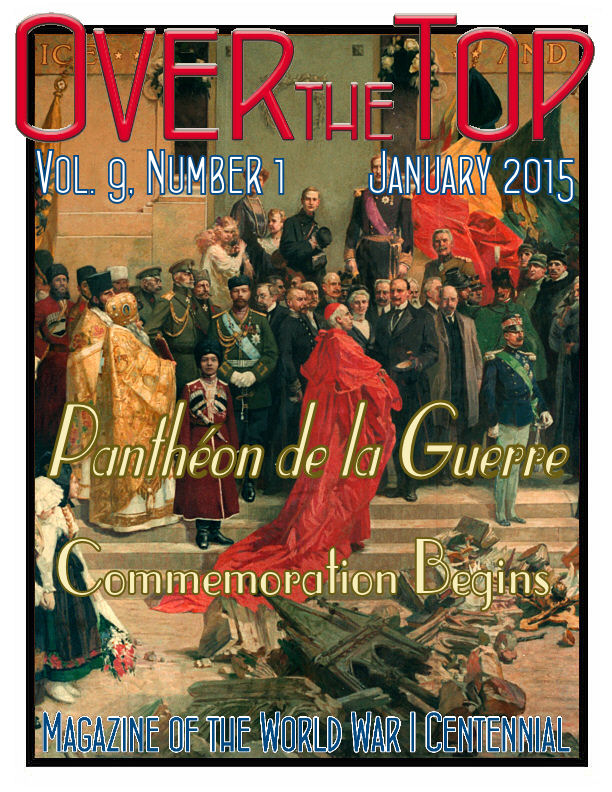
January 2015 |
 |
|


National WWI Memorials Approved
Below you will read about the recent approval of our National World War I Memorials. Most notably, you will see that site designated in our nation's capital will be at Pershing Park, a location with which most of you are probably not too familiar, or might be inclined to think lacks the prestige of being sited on the National Mall. I would like our readers to know that I enthusiastically support this location and will be asking you to do so in future editions of the Trip-Wire. For the time being, I would just ask you to read the article below in our Centennial section. It is based on press releases from the organizations involved and my discussions with members of their staffs. Next month, I will tell you about my visit to the site and every major war memorial in Washington that I made last June, and how I came to see what a wonderful opportunity the location of Pershing Park presents for honoring those who served in the Great War. MH

|
2015
Over the Front Quarterly Meeting
When: 31 January 2015
Where: Udvar-Hazy Center, Air and Space Museum, Dulles International Airport
Sponsor: Mid-Atlantic Chapter, League of WWI Aviation Historians (PDF Flyer)
WWI: 100 Years of Impact
When: 6-7 Feb 2015
Where: Tampa, FL
Sponsor: University of South Florida (PDF Flyer)
|
Local and Ongoing Events
The interest in the Great War generated by the Centennial commemorations has led to an explosion of local events and ongoing displays of art and artifacts from the war. We simply lack the space here to list them all. Fortunately, however, the staff of the Centennial Commission has taken on the job of providing a listing of all these presentations they hear about. We will make their current listing available here for downloading and revise the document as it becomes available to us. Click HERE to download the current list.
|
The Pity of War

Otto Dix, Self-Portrait as Prisoner of War , 1945-46
This is actually a World War II work by a painter usually associated with the Great War. As Nazi Germany collapsed, Dix was drafted into the Volkssturm along with other old men and young boys. He was promptly captured and ended the war in a French POW camp near Colmar.

Air War 1915
As the war expanded and became more "total" for the participants, combatants looked to and invested heavily in the new technology of aviation as they sought for any battlefield edge. The new year saw an explosion in the commitment to exploit air power.
 The Birth of the Fighter Plane, 1915
The Birth of the Fighter Plane, 1915
 Fokker Scourge — 1915
Fokker Scourge — 1915
 Anthony Fokker, Aviation Innovator
Anthony Fokker, Aviation Innovator
 Early Aerial Reconnaissance
Early Aerial Reconnaissance
 The Early Bomber Offensives
The Early Bomber Offensives
 Who Was History's First Ace? Read here.
Who Was History's First Ace? Read here.
 British Military Aviation in 1915
British Military Aviation in 1915

Alcohol Ration for the German Soldier
The Germans enjoyed a varied assortment of alcohol rations, ranging from small measures of beer, German wine, brandy and, most famously, schnapps. The daily schnapps rations of 125ml enjoyed by many of the German forces played a pivotal role in defining the War in the German psyche, especially from those who went on to write on their experiences of the conflict. The machine gunner and Expressionist artist Otto Dix recalled the experience in the trenches as: "Lice, rats, barbed wire, fleas, shells, bombs, caves, corpses, blood, Schnapps, mice, cats, gas, artillery, filth, bullets, mortars, fire, steel." During the 1920s, Erich Maria Remarque, author of the seminal All Quiet on the Western Front, wrote lovingly about schnapps, saying, "It is easier to write about the psychology of women than to understand schnapps; schnapps has soul." Source: Thedrinksbusiness.com Website

Why is World War I important in American history? Quite simply, the Great War generation played a critical role in constructing the modern U.S. Army, turning World War II soldiers into the most privileged veteran generation in American history, and determining what mass military service would mean for millions of American men throughout the 20th Century.
Jennifer D. Keene, Doughboys, the Great War, and the Remaking of America
|

In Memoriam
Remembering the Fallen of 1914
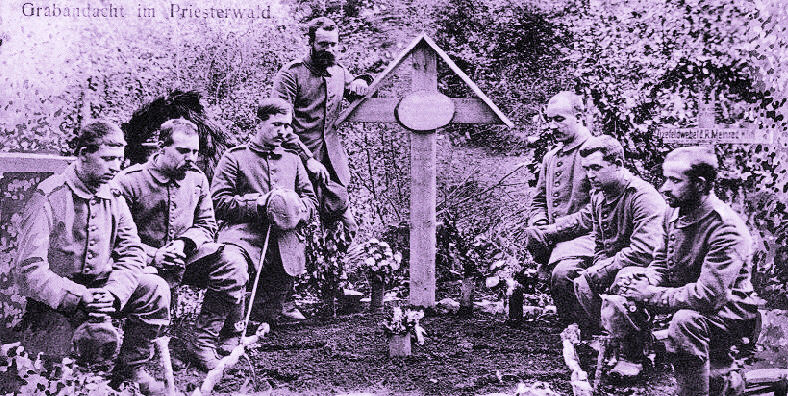
Archduke Franz Ferdinand and Sophie, Duchess of Hohenberg
Assassinated 28 June
Socialist/Pacifist Jean Jaurès
Assassinated 31 July
Corporal Andre Peugeot, French Army & Lt. Albert Mayer, German Army
First KIA of WWI, 2 August
U.S. First Lady Ellen Axson Wilson
Died of Bright's Disease 6 August
John Philip Holland, Inventor of the Modern Submarine
12 August
General James Grierson (Designated Commander II Corps BEF)
Died en route to France 17 August
General Aleksandr Samsonov, Commander Russian Second Army
Suicide 30 August
|
Lt. Charles Péguy, French Army (Author, Essayist)
KIA 5 August
Pvt. John Henry Parr, BEF, First British Soldier to Be Killed
KIA 21 August
Lt. Alain-Fournier, French Army (Novelist)
Summarily Executed 22 September
Alfred Lichtenstein, German Army (Poet)
KIA 25 September
Admiral Christopher Craddock, Royal Navy
KIA 1 November
George Trakl, Medical Service, Austrian Army (Poet)
Died of Cocaine Overdose 2 November
Admiral Maximilian von Spee, German Navy
KIA 8 December
|
The 500,000 - 1,000,000 est.
Forgotten Soldiers of All Nations
KIA 28 June - 31 December
|
|
|

U.S. Centennial Organizations & Resources
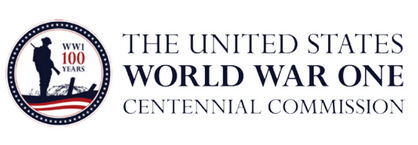
worldwar-1centennial.org/
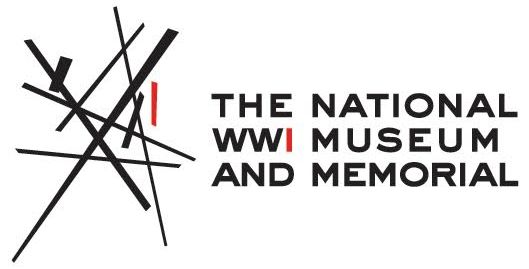
theworldwar.org/
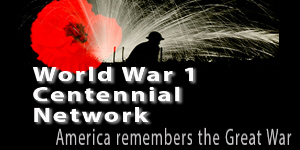
www.ww1-centennial.org/

history.army.mil/
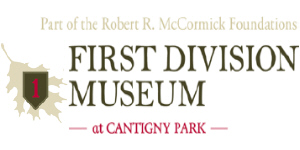
www.firstdivisionmuseum.org/

www.abmc.gov/
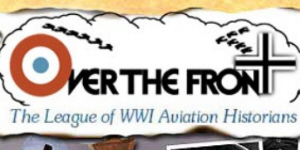
www.overthefront.com/
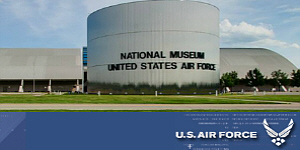
www.nationalmuseum.af.mil/
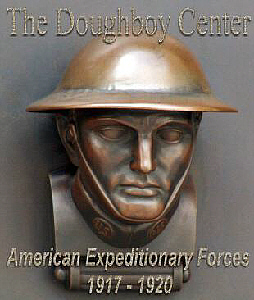
www.worldwar1.com/dbc/
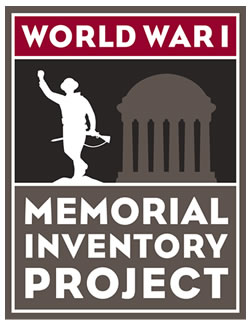
wwi-inventory.org/

wisconsinhistory.org/
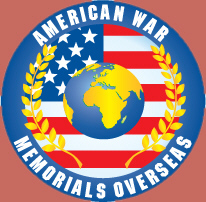
www.uswarmemorials.org/
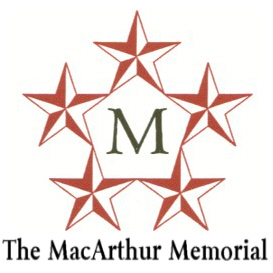
www.macarthurmemorial.org/

www.saving-hallowed-ground.org/
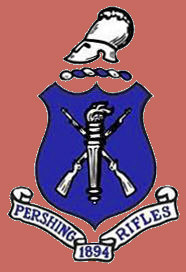
www.theprgroup.org/
|
The Centennial Ticker
America's National WWI Memorials Authorized by Congress and the President
With the President's signature of the FY 2015 National Defense Authorization Act, H.R. 4435, on 20 December, 2014, the United States government officially approved redevelopment of Pershing Park in Washington, DC, designating it as the National World War I Memorial.
Pershing Park, located on Pennsylvania Avenue one block from the White House in front of the Willard Hotel, currently contains a statue of General John J. Pershing, leader of the American Expeditionary Forces (AEF) in World War I. The commission intends to transform Pershing Park from an urban park that incidentally contains commemorative elements into a memorial that is located in an urban park setting, with the commemorative elements as the focal aspect of the site.

Pershing Park Location, About 300 Yards from the White House
(Click on Image for Larger Scale View)
This expansion of the Pershing memorial to a national-level memorial will complete the quartet of national memorials in Washington to the four great wars of "the American Century" — World War I, World War II, Korea, and Vietnam. This new World War I Memorial will be designed to honor the 4.7 million Americans who served in U.S. armed forces during the war, and the millions more who served at home and in civilian capacities.
The United States World War I Commemoration Commission did not pursue earlier proposals to establish a new memorial on the National Mall or to expand the District of Columbia War Memorial on the Mall into a national memorial. Because the Commemorative Works Act prohibits any new memorials on the Mall, the commission chose to recommend to Congress that Pershing Park be redeveloped as the National World War I memorial in Washington.
The legislation also designates Kansas City’s National World War I Museum at Liberty Memorial as the National World War I Museum and Memorial. The National World War I Museum at Liberty Memorial is the only American museum solely dedicated to examining the personal experiences of a war whose impact still echoes in the world today. The museum holds the most diverse collection of World War I objects and documents in the world and is the second-oldest public museum dedicated to preserving the objects, history, and experiences of the war. The museum takes visitors of all ages on an epic journey through a transformative period and shares deeply personal stories of courage, honor, patriotism, and sacrifice. Located in downtown Kansas City, MO, the Liberty Memorial complex inspires thought, dialogue and learning to make the experiences of the Great War era meaningful and relevant for present and future generations.
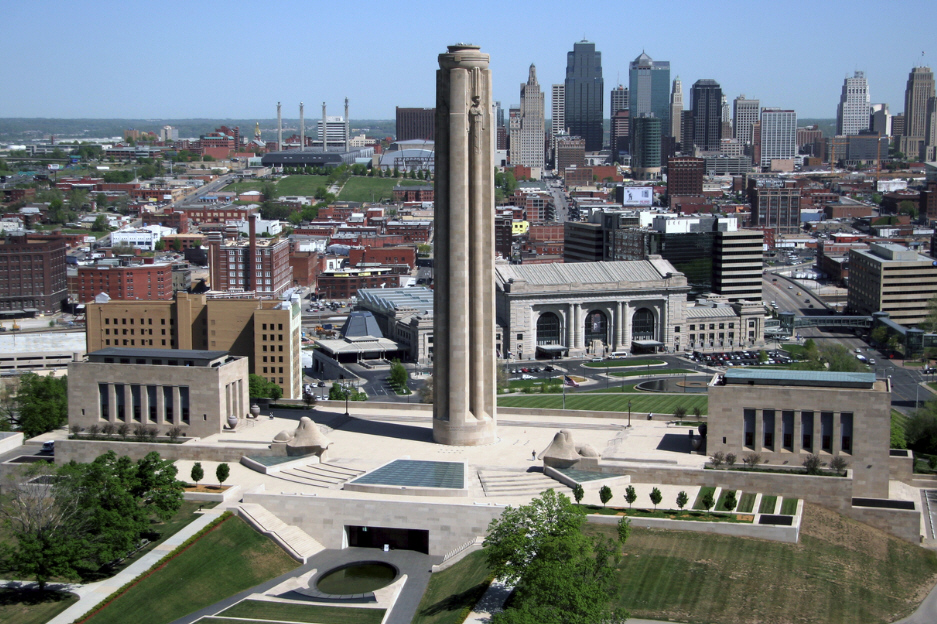
Liberty Memorial and National Museum, Kansas City, MO
The museum concluded 2014 with a record 172,148 paid visitors. "The past 12 months have truly been remarkable for the National World War I Museum," said National World War I Museum President and CEO Dr. Matthew Naylor. "This year marks the beginning of the Centennial of the Great War and during the course of the year, we’ve received an additional designation from Congress, fostered partnerships with organizations across the world, set a Museum record for public program attendance and have now set a record for paid attendance as well. We would like to thank each of the guests who attended the Museum in 2014 for helping us reach this milestone."
"With these memorials, the country will honor the service and sacrifice of American servicemen and women in the Great War in a manner commensurate with the memorials to our veterans of the later wars of the 20th century," said Commission Chairman Colonel Robert J. Dalessandro, USA (Ret.). "The centennial of World War I, which began this year, provides a timely and essential opportunity to remember that service, and the memorial will encourage greater education of the American people about our most forgotten war."
"Pennsylvania Avenue is the most prominent boulevard in the nation’s capital, and Pershing Park, located one block from the White House and with a commanding view of Capitol Hill, is a fitting location for the country’s tribute to its World War I veterans," Dalessandro said.
The commission will sponsor a privately funded design competition for the memorial. Under the legislation, "no federal funds may be obligated or expended for the designation, establishment, or enhancement of a memorial or commemorative work by the World War One Centennial Commission." The commission hopes to dedicate the new memorial by 11 November 2018, the 100th anniversary of the Armistice that ended the war.
Pritzker Museum of Chicago Makes Major Contribution to Support the Centennial Commemoration
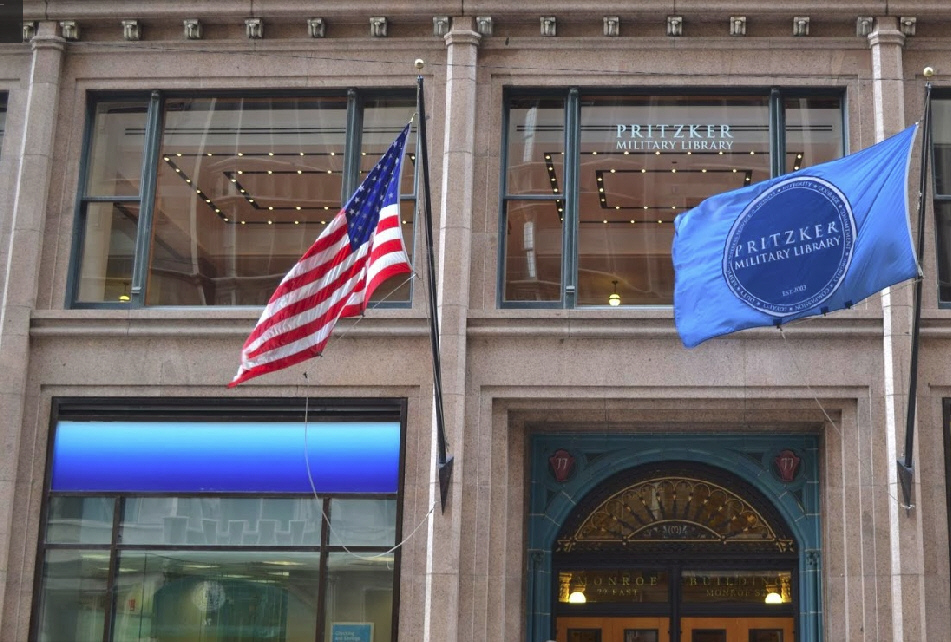
The Pritzker Library and Museum, Chicago, IL
The U.S. World War I Centennial Commission has received a $5 million gift from the Pritzker Military Museum & Library. Commission Chairman Colonel Robert J. Dalessandro, USA (Ret.) said half the gift will be used to match other donations to the commission. The gift will fund partnership activities to include the publication of the official U.S. World War I Centennial coffee table book, a number of television programs, an exhibit, and development and distribution of a commemorative coin.
Dalessandro stated, "The generosity of the Pritzker Military Museum & Library will allow the commission to further our efforts toward honoring the men and women who served and sacrificed, both overseas and on the home front, during the First World War. American's first modern millennials, they bridged the Gilded Age and the Modern Era birthing both the 'Greatest Generation' and the American Century that followed."
Museum & Library Founder and Chair, Jennifer Pritzker concurred, stating, "As an institution dedicated to preserving and sharing the history and heritage of the citizen soldier, the Pritzker Military Museum & Library is proud to support the Centennial Commission in similarly preserving and sharing the history of World War I, so that we can learn lessons from the past to apply to the future." Pritzker is a retired colonel of the Illinois Army National Guard, who cites the World War I service of both her grandfathers as a personal reason for getting involved. "Through this partnership, we will strive to give the centennial the recognition it deserves by producing a new book, unveiling a new exhibit, and hosting a wide range of programs with some of the foremost experts on the subject."
Sources: Thanks to Dan Dayton and Meredith Carr of the National Commission and Mike Vietti of the National Museum for this information on the memorials and contributions.
Did You Know About Canada's Memorial at Arlington?
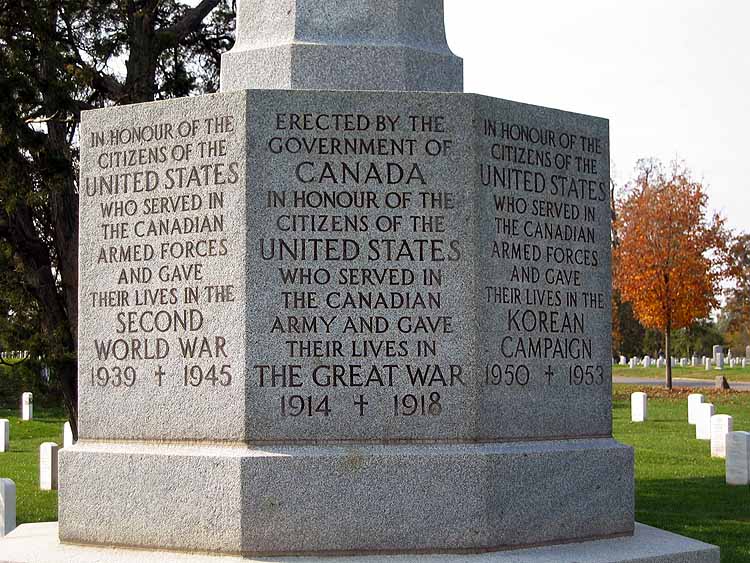
Learn More Here
|
|

The War in 1915
Overview
In this year's editions of the St. Mihiel Trip-Wire, Over the Top magazine, and our daily blog Roads to the Great War you will see that 1915 is a simply fascinating period to study as the war expanded and truly became a world war. This image captures some of the stories we will be incorporating into our Centennial look at the Great War.
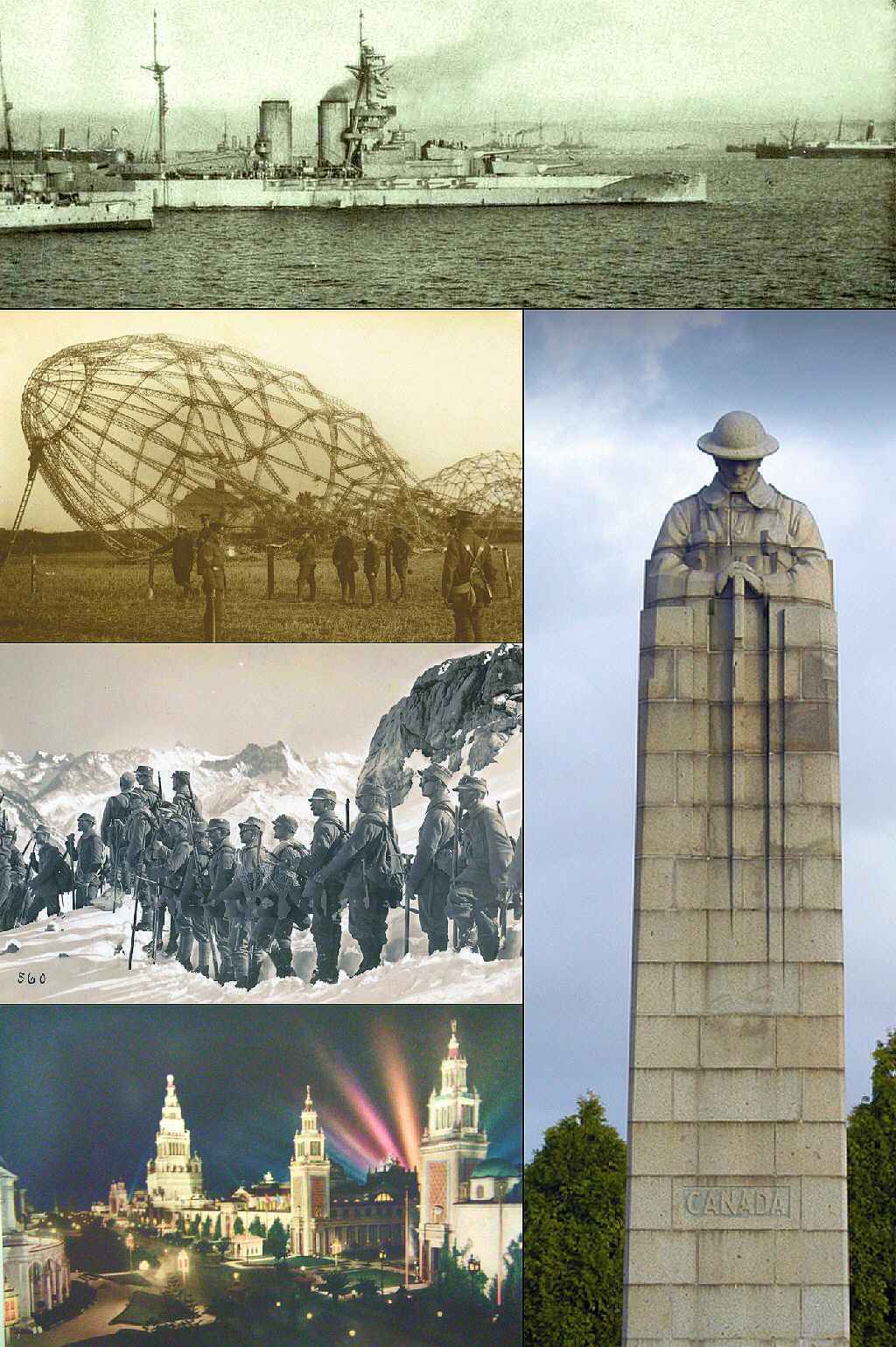
From the Top: HMS Queen Elizabeth prepares for the doomed naval assault on the Dardanelles; a zeppelin downed over Essex; the "Brooding Canadian Soldier" commemorates the first gas attack on the Western Front north of Ypres; Austrian mountain troops in the Italian Alps; a World's Fair in San Francisco in the midst of a world war
|
|

We Are Now Accepting Bookings for Our 2015 Centennial Tours:
Gallipoli and the Dardanelles Tour
News Flash!!!
Our 100th Anniversary of Gallipoli Tour, to be conducted in collaboration with Mat McLachlan Battlefield Tours of Australia, NOW HAS ADDITIONAL SEATS AVAILABLE! Contact Valor Tours ASAP.
Western Front Tours — Full Combined Brochure Now Available
2-10 May 2015: I will lead this tour and cover the 1914 and 1915 Battles North of Paris, including the Aisne & the Race to the Sea, the Siege of Antwerp, the First and Second Battles of Ypres, the Christmas Truce, and the French and British Battles in Artois.
15-23 August 2015: My summer Centennial expedition will cover the Western Front Battles of 1914 and 1915 East of Paris in the Chemin des Dames, Champagne, Argonne, and St. Mihiel sectors, PLUS the American Battlefields of 1918 at Château-Thierry, Blanc Mont, St. Mihiel, and the Meuse-Argonne. Deposits received by 15 February 2015 will result in a 5% reduction in the tour costs. Full payment by that date will result in a 10% discount.
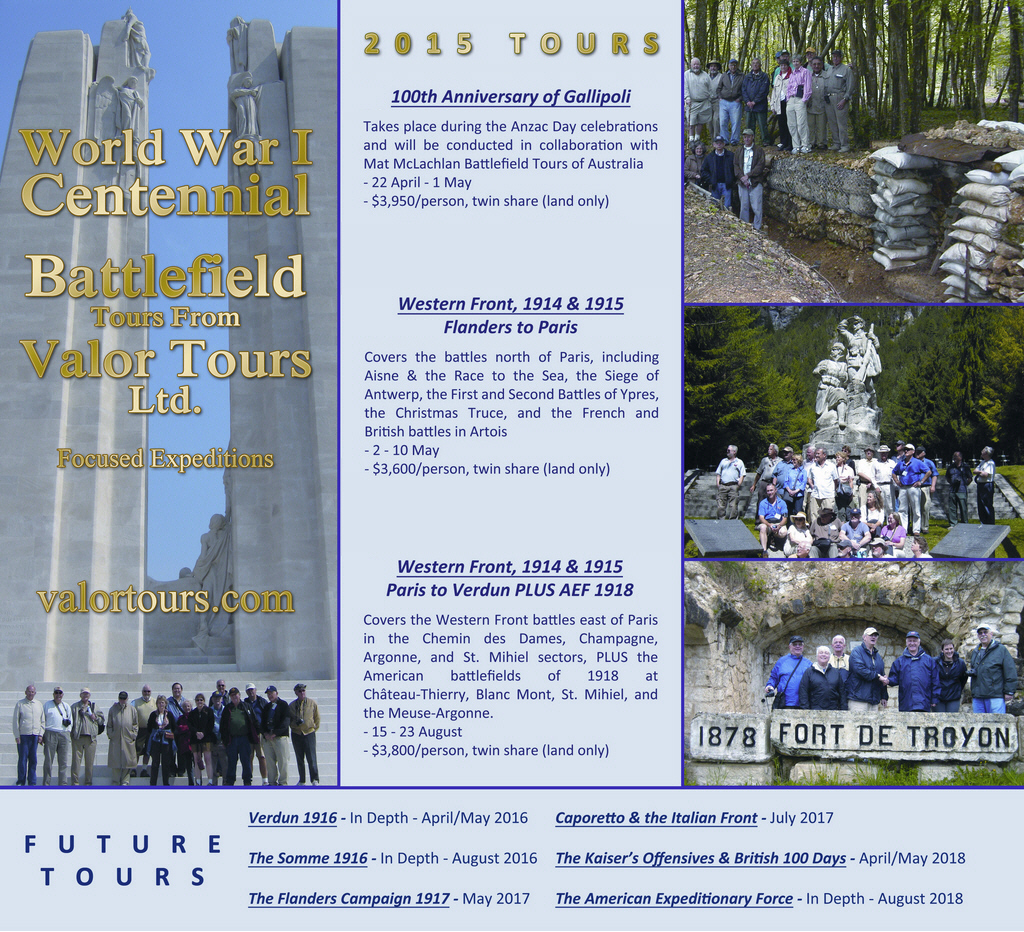
Click on Image to Send Email
|
|
|

|

The War in 1915
Here are our recommended books on the Great War in 1915 — they will refresh and deepen your understanding of this pivotal year and help you follow along as the Centennial Commemoration unfolds throughout the year. MH
|

Gallipoli to Be Commemorated in 2015
|
2015 marks the centennial of the Dardanelles-Gallipoli Campaign and it will receive a lot of media coverage. For an earlier article on those events for another of my publications, I looked long and hard for a quote I think is attributed to that expert on military affairs, Napoleon Bonaparte. It was to the effect that to understand a battlefield one had to go and see it for oneself. I failed to find the citation, but, in any case, I believe the sentiment to be true. This came to mind after leading my first tour group to Turkey in 2009 for a visit to the battlefields around the Dardanelles and on the Gallipoli Peninsula. I had been reading about the 1915 campaign for 30 years and had built up a four-dimensional mental construct of what happened there. Actually visiting these places, however, simply
shattered those impressions — much more so than my first visit to the Western Front in 1989 had for that sector. I will be trying this year to regularly discuss the unfolding of that ill-fated expedition and share some of my impressions from the two visits I've made to the area.
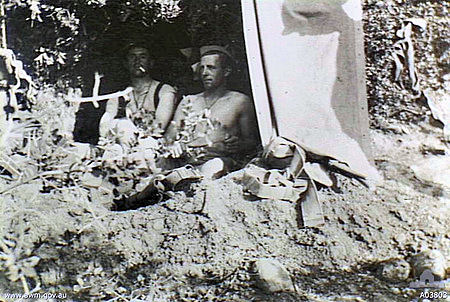
Two Members of the 14th Battalion, AIF, at Gallipoli
It was 100 years ago this month that Winston Churchill gained approval for what was to be a strictly naval assault on the straits. But the Turks and their defenses broke the will of the Royal Navy commanders and a land campaign was then deemed necessary after all. But as I concluded after my visit to the area, the Turkish interpretation of those events is correct. They believe that after the main naval assault of 18 March
failed they had defeated the Allies because they could
subsequently deploy enough forces to Gallipoli
Peninsula or the Asiatic side to foil any effort to control
the straits or march overland on Constantinople. Enver
Pasha declared this to be the case at the time, and, for
once, his instincts were correct. "March 18, 1915" is
Turkey's equivalent to Anzac Day, but — for them — it is to commemorate a victory. It is proclaimed as such by a large sign on a hill overlooking the largest city on the Straits, Çanakkale, and is also the name that is given to the local university.
Someone during the later commission hearings on the defeat would ask a question that should have been asked at the beginning, but wasn't: "How could a fleet 'take' a peninsula; how could it occupy Constantinople?" The forlorn Australian Diggers in the photograph above might never have been asked to occupy that dugout on the Gallipoli Peninsula had it been asked.
|
|
|

Yanks at British Hospitals
|
There was an unexpected windfall for the Allies when America joined the war — help with the enormous load of casualties in the 1917 campaign. The first American military installation in France during World War I was Base Hospital No.4 (Cleveland), which arrived to cheering French crowds on 25 May 1917, nineteen days ahead of General Pershing and the nucleus of his American Expeditionary Force staff. Also known as the Lakeside Unit, the Cleveland unit served at Rouen throughout the war. American physicians, nurses, and enlisted men such as these would be the earliest AEF participants to face the possibility of death and destruction — actually months before the first American soldiers would see combat.
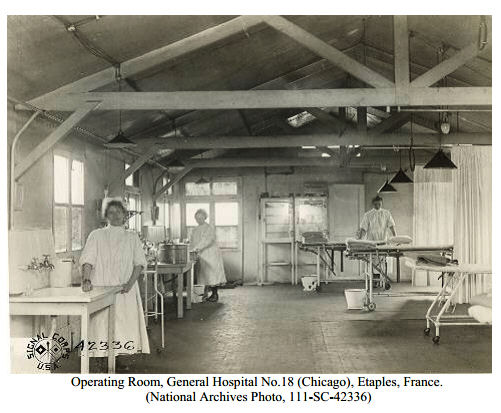
The British relied heavily on these American units. By 1917, their Medical Department was having trouble handling the massive numbers of casualties. The numbers of casualties treated by the American base hospitals with the British demonstrates the heavy load of patients.
Base Hospital No.4 treated 82,179; No. 10 treated 47,811, and No. 21 treated about 60,000. These numbers do not include the numbers of patients the Americans treated at the casualty clearing stations or while working with British units. Overall, a daily average of approximately 800 officers, 600 nurses, and 1,100 soldiers was serving with the British.
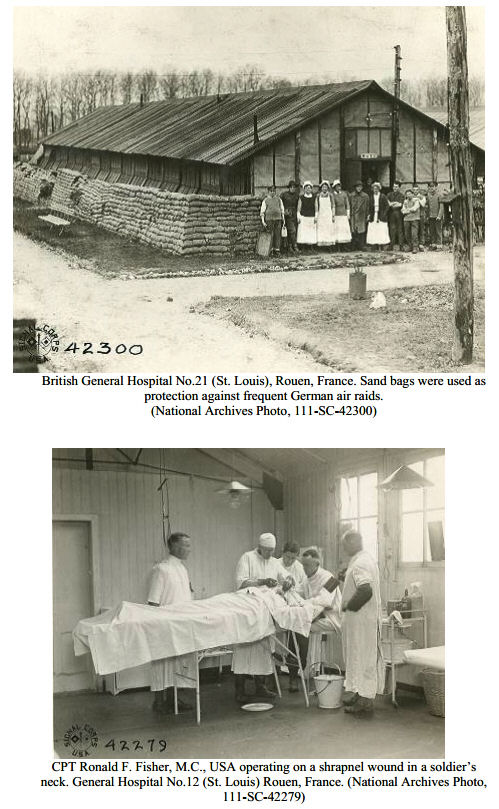
One of the hazards they faced was German night bomber raids, which attacked hospitals despite the Red Cross markings. Tragedy struck 4 September 1917, when the Germans bombed Base Hospital No. 5 at Camiers, killing Lieutenant William T. Fitzsimmons and Privates Oscar C. Tugo, Rudolph Rubino, Jr., and Leslie G. Woods, who became the first A. E. F. casualties by enemy action..
Sources: U.S. Army Surgeon General Reports and Official History
|
|
|
Thanks to each and every one of you who has contributed material for this issue. Until our next issue, your editor, Mike Hanlon. |
|
 (Or send it to a friend)
(Or send it to a friend)
|
Design by Shannon Niel
Content © Michael E. Hanlon
|
|
|








